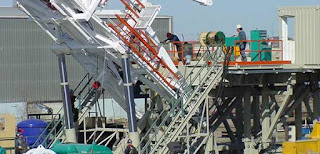CPI Internal Draw Wire Position Sensors Replace External Sensors in Oilfield Mast Raiser System.
If you’ve spent more than 5 seconds perusing the CPI Website, then you know that toughness and durability are the primary attributes of everything we make. Nowhere is this more apparent than in our newest SL2000MS, our hybrid design, long stroke linear position sensor for hydraulic cylinders and accumulators.
Our best clients for this technology are companies making long stroke hydraulics destined for some of the toughest environments in the world, and some of the toughest can be found in the world of Oil and Gas exploration both onshore and offshore. In these deployments 10 meter stroke lengths are common, often on telescoping or multistage hydraulic cylinders where achieving accurate position sensing is both extremely tough, and critically necessary.
CPI SL2000 Deployed into Oil Rig Mast Raiser System
Hydraulic cylinders deployed into oilfield mast raiser systems are going to be asked to endure some of the most challenging environments that hydraulic equipment will ever see on planet Earth. Temperature extremes, contamination, corrosive airbourne elements, and a demanding requirement that the actuator does not fail easily in service conspire to eliminate most position sensor technologies from consideration. Indeed, the cost of any downtime on an active rig is staggering, costing by some estimates, up to 1 million dollars a day.Recently CPI partnered with a major Hydraulic Cylinder Manufacturer to provide 6 of its SL2000 Linear Position Sensorsinto an oil industry mast raiser application for a land-based drilling platform. In this application, the CPI sensor replaces another company’s draw-wire sensor that could not survive in the application.
In the mast-raiser system, double-acting telescopic cylinders are used which start out horizontally and move to a vertical orientation during operation. When considering a replacement sensor technology, our client initially considered rod type sensors but quickly eliminated this technology owing to a few important limitations.
- Rod type sensors will have to be very long (> 10 meters) and rod sag and deformation is often a concern in strokes over 1 meter.
- Rod type sensors are fixed length and problematic for telescoping cylinders.
- Rod type sensors require extremely accurate core drilling of the piston to insert internally.
The CPI SL2000 For Endurance and Flexibility

- It is easily designed into the cylinder making field deployment and replacement easy.
- Its non-compressible nature makes it able to withstand almost any kind of hydraulic fluid, and almost any pressure in the cylinder.
- The SL2000 can be deployed horizontally or vertically in any cylinder or accumulator, even multistage cylinders where the draw wire technology is ideal.
- The sensor leverages an extremely short magnetostrictive sensor and provides absolute position measurement with high accuracy.
- The solution is ATEX and IEC-EX certified.
Contact CPI today to discuss your need for harsh duty linear position sensors.
Original content posted on https://www.cpi-nj.com/blog/Linear-Position-Sensor-Mast-Raiser-Hydraulics

Comments
Post a Comment